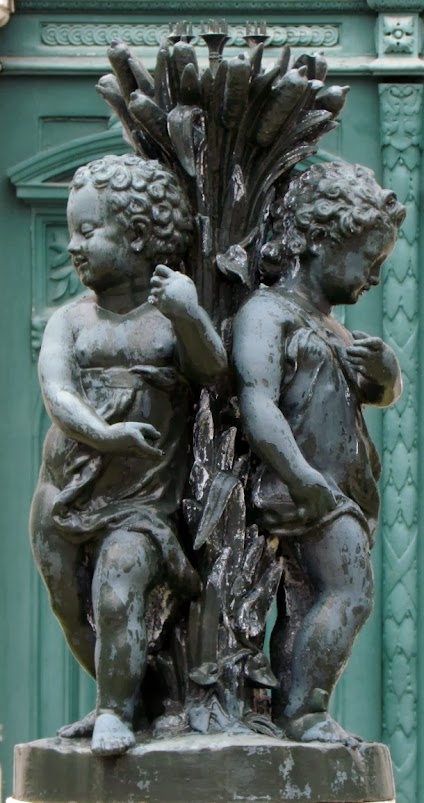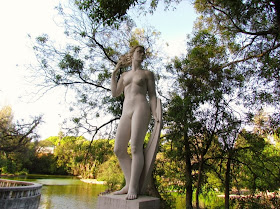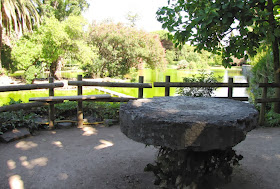A
AROUND GULBENKIAN MUSEUM - PRAÇA DE ESPANHA
B - SÃO SEBASTIÃO DA PEDREIRA
VILALVA PALACE
CHURCH OF SÃO SEBASTIÃO DA PEDREIRA
This small church has the quintessentially Portuguese Baroque interior -- large tile panels surrounded by gilding. The result is blue and white images under golden details which surprise upon entering, as the exterior is deceptively simple.
It's one of the rare survivors of the 1755 earthquake, having been inaugurated in 1652. It was dedicated to St. Sebastian, whose life is illustrated on the ceiling and on the tile panels that cover the walls.
 |
| SÃO SEBASTIÃO DA PEDREIRA - PALÁCIO VILALVA |
PARQUE EDUARDO VII
PARQUE EDUARDO VII -
N 38.73051 ; W 9.15466
The Eduardo VII Park (Portuguese: Parque Eduardo VII) is a public park in Lisbon, Portugal. The park occupies an area of 26 hectares to the north of theAvenida da Liberdade and the Marquess of Pombal Square, in the centre of the city. Its name pays homage to Edward VII of the United Kingdom who visited Portugal in 1902 to strengthen the relations between the two countries. The Lisbon Book Fair is held there annually.
C
I
JUSTICE PALACE
J
D
N 38.73051 ; W 9.15466
E
F
PAVILHÃO CARLOS LOPES
Built in Rio de Janeiro in 1921 for the city’s International Exhibition that took place between 1922 and 1923, this beautiful building was later rebuilt in Edward VII Park in Lisbon in 1929. It was named the “Palace of Exhibitions and Festivals,” but in 1946 was renamed “Sports Pavilion.” When the Portuguese athlete Carlos Lopes won the Los Angeles Olympics marathon in 1984, setting a new Olympic record, the pavilion was renamed again, to “Carlos Lopes Pavilion.”
It closed in 2003, and after several years of neglect, it was renovated in 2015 to reopen in 2017.
The renovation of the entire building provided new singular conditions to host different kinds of cultural and sporting events, but respected the historical heritage by preserving the beautiful tile panels of the interior and on the façade, and maintaining a permanent exhibition honoring the Olympic champion.
The tiles illustrate scenes from Portugal’s history, and the two large sculptures by the entrance represent Art and Science.
G
ESTUFA FRIA
Recommendations:
The Lisbon Greenhouse, due to its special characteristics with its stairs, slopes, different types of walking surfaces, lakes, etc., requires visitors to take some precautions, especially with children who need to be kept under constant supervision during the visit.
PRAÇA MARQUÊS DE POMBAL
(N 38.72684; W 9.14902)
The Marquess of Pombal Square (Portuguese: Praça do Marquês de Pombal) is an important roundabout in the city of Lisbon, Portugal. It is located between the Avenida da Liberdade (Liberty Avenue) and the Eduardo VII Park. The square is the radiating point for various important avenues: Liberdade, Duque de Loulé and Fontes Pereira de Melo, as well as the streets Braamcamp and Joaquim António de Aguiar.
Its name is a reference to Sebastião José de Carvalho e Melo, 1st Marquess of Pombal, 1st Count of Oeiras, the mighty prime-minister who ruled Portugal from 1750 to 1777. In the middle of the roundabout there is a large column dedicated to him, built between 1917 and 1934 and created by Adães Bermudes, António Couto and Francisco Santos. A bronze statue of the Marquess is on the top, with a lion - symbol of power - by his side. The Marquis is shown looking towards theBaixa Pombalina, the area of Lisbon that was rebuilt under his direction after the disastrous 1755 Lisbon Earthquake.
The Blue and Yellow lines (Linha Azul and Linha Amarela) of the Lisbon Metro (Metropolitano de Lisboa) stop at Marquês de Pombal station
The Praca do Marques de Pombal is the primary stop for all of the open air tourist buses, expect for the one operated by Carris (the yellow bus). It is here were the tour bus companies start and terminate their routes and is the location to change from one route to another. The Praca do Marquês de Pombal backs onto the large park the Parque de Eduardo VII this hill stretches uphill to the huge flag that fly’s high over Lisbon.
The statue is a beautiful piece of workmanship. At the top of the 36 meter high pedestal stands the 9 meter bronze statue of the Marquês de Pombal while the base is full of symbolism from both the 1755 earthquake and the turn of the last century. The major carvings are elephants which signify power and leadership while the rough stones and jagged rocks remembers the shattered ground after the 1755 earthquake.
.JPG) |
| The arms of the Marquis of Pombal and a caravel. |
AVENIDA DA LIBERDADE
«Liberdade Avenue and Restauradores Square have their origins in a public park (Passeio Público) inaugurated in the area in 1764. Initially surrounded by a high wall, the park was revamped in the 1830s and 1840s with a new arrangement of the flora as well as fountains, a waterfall and statues. The allegoric statues representing theTagus and Douro rivers in the boulevard of the avenue date from this time.
Many of the original buildings of the avenue have been replaced in the last decades by tall office and hotel buildings. Nowadays it boasts several interesting buildings that reflect Portuguese architecture from the late 19th through the early 21st centuries. Its pedestrian sidewalks androundabouts, paved with the traditional Portuguese pavement, are decorated with many monuments and statues that pay hommage to important personalities like Almeida Garrett, Alexandre Herculano and others. The large monument to the fallen in World War I, inaugurated in 1931, is the work of Rebelo de Andrade and Maximiano Alves.
Its scenic qualities, hotels, shops, theatres and architecture turn it into an important tourist attraction of the city. Famous nationally for hosting numerous luxury brands like Christian Dior, Chanel, Versace, Balmain, Gucci, Givenchy, Yves Saint Laurent, Michael Kors, Stella McCartney, Christian Louboutin, Donna Karan and others like Louis Vuitton, Prada, Dolce & Gabbana, Armani, Todd's, Burberry. It is nowadays considered as the 35th most expensive avenue in the world.
 |
| LISBOA (1959) - Avenida da Liberdade/ Rua do Salitre |
 |
| 1959 |
+-+5.JPG) |
PASSEIO PÚBLICO, INAUGURATED IN 1764
«Liberdade Avenue and Restauradores Square have their origins in a public park (Passeio Público) inaugurated in the area in 1764. Initially surrounded by a high wall, the park was revamped in the 1830s and 1840s with a new arrangement of the flora as well as fountains, a waterfall and statues. The allegoric statues representing theTagus and Douro rivers in the boulevard of the avenue date from this time.
















































































































































































































.JPG)
+-+1.jpg)
+-+2.jpg)
.JPG)
.JPG)
.JPG)
+-+A.jpg)
+-+Bp+eduardo+7+1953.jpg)
+-+Cmarques+1930.jpg)
+-+DMAR-1934.jpg)
+-+E.jpg)
+-+A.JPG)
+-+A.JPG)
+-+B.JPG)
+-+E.JPG)
+-+F.JPG)
+-+G.JPG)
+-+H.JPG)
+-+I.JPG)
+-+J.JPG)
+-+K.JPG)
+-+M.JPG)
+-+N.JPG)
+-+O.JPG)
+-+P.JPG)
+-+Q.JPG)
+-+R.JPG)
+-+S.JPG)
+-+T.JPG)
+-+U.JPG)
+-+W.JPG)
+-+X.JPG)
+-+Z.JPG)
+-+C.JPG)
+-+E.JPG)
.JPG)
+-+B.JPG)
+-D.JPG)
.JPG)
.JPG)
.JPG)



+-+5.JPG)
.JPG)
.JPG)
.JPG)
+-+2.jpg)
+-+3.JPG)
+-+4.JPG)
+-+6.JPG)
+-+7.JPG)
+-+8.JPG)
+-+9.JPG)
+-+10.JPG)
.JPG)
.JPG)
.JPG)
.JPG)
.JPG)
+-+B.jpg)
+-+C.JPG)
+-+F.JPG)
+-+H.JPG)
.JPG)
.JPG)
+-+1.JPG)
.JPG)
-1930.jpg)
.JPG)
+-+1.jpg)
+-+2.jpg)
.jpg)
.JPG)
.jpg)
.JPG)
.jpg)
.jpg)
.JPG)
.jpg)
.JPG)
+-+1.JPG)
+-+2.JPG)
+-+3.JPG)
+-+4.JPG)
.JPG)
+-+1.JPG)
+-+2.JPG)
.JPG)
.JPG)
.JPG)
.jpg)
.JPG)
.JPG)
.JPG)
.jpg)
.jpg)
.jpg)
+-+B.JPG)
+-A.JPG)
+-+1.JPG)
+-+2.JPG)
.jpg)
+-+2.JPG)
.JPG)
.JPG)
+-+1.JPG)
+-+2.JPG)
+-+7.JPG)
.JPG)
.JPG)
+-+1.jpg)
+-2.JPG)
+-+3.JPG)
.JPG)
.JPG)
+-+1.JPG)
+-+1900.jpg)
+-+1886.jpg)
.JPG)
.jpg)


